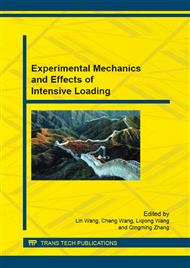[1]
Y. Kitahara, K. Ikeda, H. Shimazaki, H. Noguchi, M. Sakamoto and H. Ueno, Fatigue strength characteristics of non-combustible Mg alloy, Transactions of the Japan Society of Mechanical Engineers (series A) 72, 717, (2006), pp.661-668.
DOI: 10.1299/kikaia.72.661
Google Scholar
[2]
K. Masaki, Y. Ochi, T. Kakiuchi, K. Kurata, T. Hirasawa, T. Matsumura, Y. Takigawa and K. Higashi, High cycle fatigue property of extruded non-combustible Mg Alloy AMCa602, Materials Transactions, 49, 5, (2008), pp.1148-1156.
DOI: 10.2320/matertrans.mc2007108
Google Scholar
[3]
T. Fujii, K. Morishige, S. Hamada, H. Noguchi, M. Sakamoto and H. Ueno, Fatigue strength characteristics of non-combustible Mg Alloy, Journal of Solid Mechanics and Materials Engineering, 2, 6, (2008), pp.763-770.
DOI: 10.1299/jmmp.2.763
Google Scholar
[4]
F. Yang, S. M. Yin, S. X. Li and Z. F. Zhang, Crack initiation mechanism of extruded AZ31 magnesium alloy in the very high cycle fatigue regime, Materials Science and Engineering A 491, 1-2, (2008), pp.131-136.
DOI: 10.1016/j.msea.2008.02.003
Google Scholar
[5]
K. Shiozawa, T. Kashiwagi, T. Murai and T. Takahashi, Fatigue behavior and fractography of extruded AZ80 magnesium alloys in very high cycle regime, Procedia Engineering, 2, (2010), pp.183-191.
DOI: 10.1016/j.proeng.2010.03.020
Google Scholar
[6]
Y. Ochi, K. Masaki, T. Hirasawa, X. Wu, T. Matsumura, Y. Takigawa and K. Higashi, High cycle fatigue property and micro crack propagation behavior in extruded AZ31 magnesium alloys, Materials Transactions, 47, 4, (2006), pp.989-994.
DOI: 10.2320/matertrans.47.989
Google Scholar
[7]
K. Tokaji, M. Kamakura, Y. Ishizumi and N. Hasegawa, Fatigue behaviour and fracture mechanism of a rolled AZ31 magnesium alloy, International Journal of Fatigue, 26, 11, (2004), pp.1217-1224.
DOI: 10.1016/j.ijfatigue.2004.03.015
Google Scholar
[8]
T. Kakiuchi, Y. Ochi, K. Tanaka and T. Matsumura, Effect of surface texture and humidity environment on high cycle fatigue property of wrought magnesium alloys AZ31 and AZ61, Journal of Solid Mechanics and Materials Engineering 4, 11, (2010).
DOI: 10.1299/jmmp.4.1722
Google Scholar
[9]
T. S. Shih, W. S. Liu and Y. J. Chen, Fatigue of as-extruded AZ61A magnesium alloy, Materials Science and Engineering, A325 (2002), pp.152-162.
DOI: 10.1016/s0921-5093(01)01411-3
Google Scholar
[10]
D. K. Xu, L. Liu, Y. B. Xu and E. H. Han, The crack initiation mechanism of the forged Mg-Zn-Y-Zr alloy in the super-long fatigue life regime, Scripta Materialia, 56, (2007), pp.1-4.
DOI: 10.1016/j.scriptamat.2006.09.006
Google Scholar
[11]
S. A. Khan, Y. Miyashita, Y. Mutoh and Z. B. Sajuri, Influence of Mn content on mechanical properties and fatigue behavior of extruded Mg alloys, Materials Science and Engineering, A 420, (2006), pp.315-321.
DOI: 10.1016/j.msea.2006.01.091
Google Scholar
[12]
T. Sakai, Y. Ochi and J. W. Jones, Special issue on the international conference on very high cycle fatigue (VHCF-3) held in Kyoto/Kusatsu, Japan, International Journal of Fatigue, 28, 11, (2006), p.1437.
DOI: 10.1016/j.ijfatigue.2006.02.045
Google Scholar
[13]
K. S. R. Chandran, G. T. Cashman, J. M. Larsen and T. Sakai, Special issue on competing failure modes and variability in fatigue, International Journal of Fatigue, 32, 3, (2010), p.481.
DOI: 10.1016/j.ijfatigue.2009.08.006
Google Scholar
[14]
JSMS Committees on Fatigue of Materials and Reliability Engineering, Standard Regression Method of S-N Curves, The Society of Materials Science, Japan, (2008).
Google Scholar
[15]
R. E. Peterson: Stress concentration design factors, John Wiley & Sons, Inc., (1953).
Google Scholar
[16]
T. Sakai, T. Furusawa, R. Takizawa, N. Oguma, H. Hohjo and H. Ikuno, Development of multi-type high efficiency fatigue testing machines in rotating bending and axial loading, Proceedings of the Hael Mughrabi Honorary Symposium, TMS Annual Meeting, (2008).
Google Scholar
[17]
T. Yamamoto, A. Kokubu, T. Sakai, Y. Nakamura, Development and Several Additional Performances of Dual-Spindle Rotating Bending Fatigue Testing Machine GIGA QUAD, Proceedings of VHCF-6, (2014), [AAI06].
DOI: 10.1299/jsmekansai.2014.89._11-9_
Google Scholar
[18]
T. Sakai, Review and prospects for current studies on very high cycle fatigue of metallic materials for machine structural use, Journal of Solid Mechanics and Materials Engineering, 3, 3, (2009), pp.1573-1587.
DOI: 10.1299/jmmp.3.425
Google Scholar
[19]
M. Nakajima, N. Kamiya, H. Itoga, K. Tokaji and H. N. Ko, Experimental estimation of crack initiation lives and fatigue limit in subsurface of a high carbon chromium steel, International Journal of Fatigue, 28, 11 (2006), pp.1540-1546.
DOI: 10.1016/j.ijfatigue.2005.05.017
Google Scholar
[20]
K. S. R. Chandran, P. Chang and G. T. Cashman, Competing failure modes and complex S-N curves in fatigue of structural materials, International Journal of Fatigue, 32, 3, (2010), pp.482-491.
DOI: 10.1016/j.ijfatigue.2009.08.004
Google Scholar
[21]
G. T. Cashman, A review of competing modes fatigue behavior, International Journal of Fatigue, 32, 3, (2010), pp.492-496.
DOI: 10.1016/j.ijfatigue.2009.04.018
Google Scholar
[22]
W. Li, T. Sakai, M. Wakita and S. Mimura, Effect of surface finishing and loading condition on competing failure mode of clean spring steel in very high cycle fatigue regime", Materials Science and Engineering, A, Vol. 552, (2012), pp.301-309.
DOI: 10.1016/j.msea.2012.05.044
Google Scholar
[23]
T. Sakai, B. Lian, M. Takeda, K. Shiozawa, N. Oguma, Y. Ochi, M. Nakajima, T. Nakamura, Statistical duplex S-N characteristics of high carbon chromium bearing steel in rotating bending in very high cycle regime, International Journal of Fatigue, Vol. 32, 3, (2010).
DOI: 10.1016/j.ijfatigue.2009.08.001
Google Scholar
[24]
K. Shiozawa, M. Murai, Y. Shimatani and T. Yoshimoto, Transition of fatigue failure mode of Ni-Cr-Mo low-alloy steel in very high cycle regime, International Journal of Fatigue, 32, 3, (2010), pp.541-550.
DOI: 10.1016/j.ijfatigue.2009.06.011
Google Scholar
[25]
S. Ando and H. Tonda, Deformation and fatigue behaviors in Mg, Materia Japan, 42, 2, (2003), pp.124-132.
Google Scholar
[26]
M. Battaini, E. V. Pereloma and C. H. J. Davies, Orientation effect on mechanical properties of commercially pure titanium at room temperature, Metallurgical and Materials Transactions A 38, 2, (2007), pp.276-285.
DOI: 10.1007/s11661-006-9040-2
Google Scholar
[27]
Y. Murakami and M. Endo, Effects of defects, inclusions and inhomogeneities on fatigue strength, International Journal of Fatigue, 16, 3, (1994), pp.163-182.
DOI: 10.1016/0142-1123(94)90001-9
Google Scholar
[28]
Z. Nan, S. Ishihara, T. Goshima and R. Nakanishi, Fatigue behavior of AZ31 extruded magnesium alloy in laboratory air, Transactions of the Japan Society of Mechanical Engineers, 70, 696, (2004), pp.1146-1152.
DOI: 10.1299/kikaia.70.1146
Google Scholar


